About a kilometre north-east of Soğucak, along the valley of Kaynak Dere is a large and distinctive rock. Because it bears a superficial resemblance to the hull of a galleon, it is referred to locally as Gemi Kaya or Ship Rock. Such a noticeable feature was destined to be the focus of religious activity. Kırklareli’s Culture and Tourism website provides an educated guess that some kind of worship has been happening on the rock since the early Iron Age. The most distinctive man-made contribution to Gemi Kaya is the Byzantine chapel on the easternmost point.
As one approaches from the north-east, one passes along a line of cliffs, many with the marks of past building activity still visible. Presumably, communities have lived here for a long time. The isolation that may have provided an advantage in more warlike times is no longer a plus and people have moved to places to which it is possible to build roads.
The top of Gemi Kaya itself is pitted with pre-Roman marks, probably of bygone religious significance. The most obvious structures cut from the rock are Byzantine, particularly the chapel. This is a long, narrow building: the best art of ten metres in length but little more than 2 metres wide. It is aligned on an east-west axis with the apse perched precariously over the prow of the rock. It must have had an impressive triptych of windows in the apse but erosion has taken care of those and has left Gemi Kaya with a gap-toothed profile. At floor level, the apse has been carved into the shape of a synthronon, ambitious in such a narrow structure. There are plenty of sockets and mortises to give clues as to the wooden bits that attached to the rock and allowed a substantial, weather-proof building to be made. There are also substantial niches in the walls of the chapel. Treasure hunters have inexplicably pounded an ugly hole into the northern wall of the chapel. Why they thought treasure might be hidden in virgin rock is not recorded.
There is an interesting room immediately to the north of the chapel. It is a rough square with sides around 2 metres in length. A window has been carved into the rock and gives a view to the east. Maybe a solitary prayer room. Difficult to tell after so much time and weathering.
A few metres below the chapel level, a terrace stretches the length of Gemi Kaya on its south side. Here there are the remains of buildings and a large number of rectangular graves.
There is allegedly a sundial somewhere on the rock but I have been unable to find it. I presume that someone has done a bit of study on Gemi Kaya. Id like a bit more explanation about the thing.
Civelek, E. (2016) Koru Eski Yerleşim Alanı ve Kült Alanı, (Gemi Kaya) Kırklareli Kültür Varlıkları Envanteri. Available online at http://www.kirklarelienvanteri.gov.tr/sitler.php?id=135 Accessed 3th June 2016

Posted July 1, 2016 Posted by Adam in Uncategorized
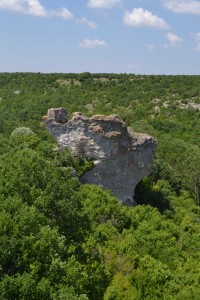
Gemi Kaya from the top of the cliff to the north-west
About a kilometre north-east of Soğucak, along the valley of Kaynak Dere is a large and distinctive rock. Because it bears a superficial resemblance to the hull of a galleon, it is referred to locally as Gemi Kaya or Ship Rock. Such a noticeable feature was destined to be the focus of religious activity. Kırklareli’s Culture and Tourism website provides an educated guess that some kind of worship has been happening on the rock since the early Iron Age. The most distinctive man-made contribution to Gemi Kaya is the Byzantine chapel on the easternmost point.
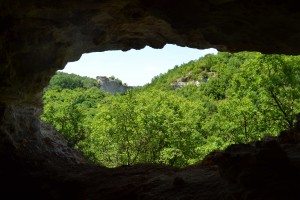
Gemi Kaya from one of the many caves in the vicinity
As one approaches from the north-east, one passes along a line of cliffs, many with the marks of past building activity still visible. Presumably, communities have lives here for a long time. The isolation that may have provided an advantage in more warlike times is no longer a plus and people have moved to places to which it is possible to build roads.
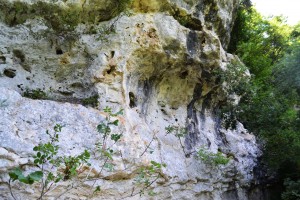
This was once a wall of a building
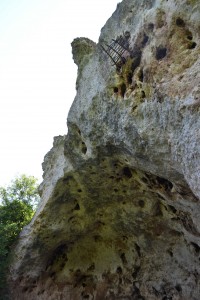
The biggest cave in the area has a mystery awning of sticks above it
The top of Gemi Kaya itself is pitted with pre-Roman marks, probably of bygone religious significance. The most obvious structures cut from the rock are Byzantine, particularly the chapel. This is a long, narrow building: the best art of ten metres in length but little more than 2 metres wide. It is aligned on an east-west axis with the apse perched precariously over the prow of the rock. It must have had an impressive triptych of windows in the apse but erosion has taken care of those and has left Gemi Kaya with a gap-toothed profile. At floor level, the apse has been carved into the shape of a synthronon, ambitious in such a narrow structure. There are plenty of sockets and mortises to give clues as to the wooden bits that attached to the rock and allowed a substantial, weather-proof building to be made. There are also substantial niches in the walls of the chapel. Treasure hunters have inexplicably pounded an ugly hole into the northern wall of the chapel. Why they thought treasure might be hidden in virgin rock is not recorded.
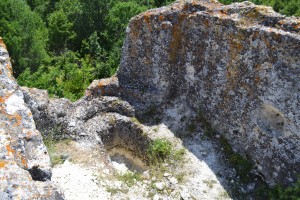
Apse of chapel from the north wall
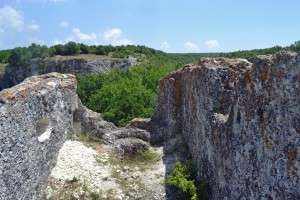
Single nave of chapel, looking west
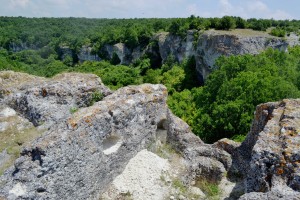
Attachment points for superstructure are visible on the rock
There is an interesting room immediately to the north of the chapel. It is a rough square with sides a little smaller than 2 metres. A window has been carved into the rock and gives a view to the east. Maybe a solitary prayer room. Difficult to tell after so much time and weathering.
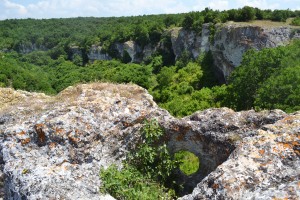
Round windowed chamber to the north of the chapel
A few metres below the chapel level, a terrace stretches the length of Gemi Kaya on its south side. Here there are the remains of buildings and a large number of rectangular graves.
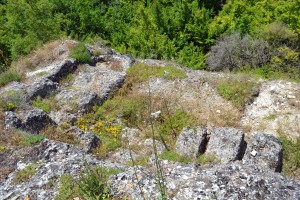
View down to the terrace from the south wall of the chapel
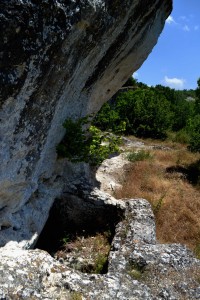
Empty grave on the southern terrace
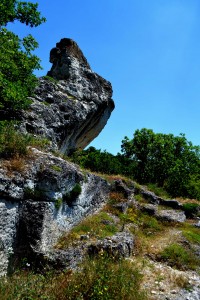
Southern terrace. The south wall of the chapel is at the top of the picture
There is allegedly a sundial somewhere on the rock but I have been unable to find it. I presume that someone has done a bit of study on Gemi Kaya. Id like a bit more explanation about the thing.
Civelek, E. (2016) Koru Eski Yerleşim Alanı ve Kült Alanı, (Gemi Kaya) Kırklareli Kültür Varlıkları Envanteri. Available online at http://www.kirklarelienvanteri.gov.tr/sitler.php?id=135 Accessed 3th June 2016

Next Entries »
